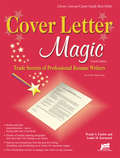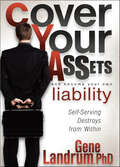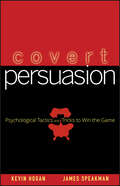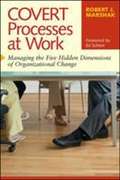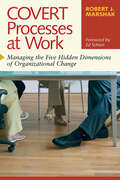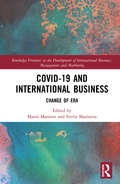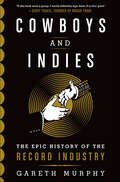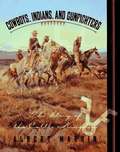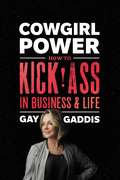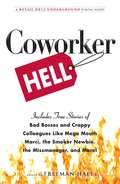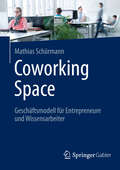- Table View
- List View
Cover Letter Magic: Trade Secrets of Professional Resume Writers
by Louise Kursmark Wendy EnelowProfessional resume and cover letter writers reveal their inside secrets for creating phenomenal cover letters that get attention and land interviews. .<P> <i>Advisory: Bookshare has learned that this book offers only partial accessibility. We have kept it in the collection because it is useful for some of our members. To explore further access options with us, please contact us through the Book Quality link on the right sidebar. Benetech is actively working on projects to improve accessibility issues such as these. </i>
Cover Letters In A Week: Write A Great Covering Letter In Seven Simple Steps
by Hilton Catt Patricia Scudamore<p>Sunday: Understand the importance of first impressions and the common mistakes people make <p>Monday: Ensure your application is taken seriously with a cover letter that is concise, complements your CV and is targeted to the job you have applied for <p>Tuesday: Discover how to style and structure your cover letter with advice on forms of address, etiquette, fonts, margins and the importance of 'white space' <p>Wednesday: Design your cover letter to engage your audience and overcome the competition for advertised jobs <p>Thursday: Design a speculative cover letter to approach the invisible job market <p>Friday: Learn how to address cover letters to agencies and recruitment consultants <p>Saturday: Learn from your applications, whether successful or not, and develop your writing style for the future</p>
Cover Letters In A Week: Write A Great Covering Letter In Seven Simple Steps
by Pat Scudamore Hilton CattSunday: Understand the importance of first impressions and the common mistakes people make Monday: Ensure your application is taken seriously with a cover letter that is concise, complements your CV and is targeted to the job you have applied for Tuesday: Discover how to style and structure your cover letter with advice on forms of address, etiquette, fonts, margins and the importance of 'white space' Wednesday: Design your cover letter to engage your audience and overcome the competition for advertised jobs Thursday: Design a speculative cover letter to approach the invisible job market Friday: Learn how to address cover letters to agencies and recruitment consultants Saturday: Learn from your applications, whether successful or not, and develop your writing style for the future
Cover Your Assets and Become Your Own Liability: Self-Serving Destroys from Within
by Gene LandrumSacrifice Tomorrow for Today and You'll have Destroyed Tomorrow! While America was landing on the moon, Japan was landing in our living room. One nation focused on the conquest of space; the other on the conquest of mass consumer markets. Cover Your Assets delves into how an export power became an importer in three decades through self-serving. CYA management and discusses the need for leadership transformation to return to the days of glory. The cost of a nation's leadership adopting a take care of me now mentality is huge. When they sacrifice tomorrow for today, they have sold tomorrow. CYA includes a self-assessment on how to change personally and professionally. There is a need to zap the Yes Men in our heads and understand what makes us tick. Those who don't are hard-pressed to understand how to manage, motivate or control others. We all have a need to feel good today but too much of today leads to too little tomorrow.
Coverage Matters: Insurance and Health Care
by Institute of MedicineRoughly 40 million Americans have no health insurance, private or public, and the number has grown steadily over the past 25 years. Who are these children, women, and men, and why do they lack coverage for essential health care services? How does the system of insurance coverage in the U.S. operate, and where does it fail? The first of six Institute of Medicine reports that will examine in detail the consequences of having a large uninsured population, Coverage Matters: Insurance and Health Care, explores the myths and realities of who is uninsured, identifies social, economic, and policy factors that contribute to the situation, and describes the likelihood faced by members of various population groups of being uninsured. It serves as a guide to a broad range of issues related to the lack of insurance coverage in America and provides background data of use to policy makers and health services researchers.
Covered Calls and LEAPS--A Wealth Option + DVD
by Robert Kiyosaki Joseph R. Hooper Aaron R. ZalewskiIn this one-of-a-kind "how-to" guide, Joseph Hooper and Aaron Zalewski provide step-by-step instructions for generating large monthly cash returns from almost any stock investment--while at the same time decreasing the risk of stock ownership. Filled with in-depth insights and proven techniques, this book is the definitive, rule-based guide to covered calls and calendar LEAPS spreads.
Covert Cows and Chick-fil-A: How Faith, Cows, and Chicken Built an Iconic Brand
by Steve RobinsonThe longtime chief marketing officer for Chick-fil-A tells the inside story of how the company turned prevailing theories of fast-food marketing upside down and built one of the most successful and beloved brands in America.Covert Cows will help you… Discover unexpected, out-of-the-box marketing methods and new ways of approaching business problems.Understand the positive impact of building a business based on biblical principles.Receive an insider&’s look at the evolution of one of America&’s most beloved brands.Learn key marketing and business insights from the man who was the chief marketing officer for Chick-fil-A for thirty-four years.During his thirty-four-year tenure at Chick-fil-A, Steve Robinson was integrally involved in the company&’s growth--from 184 stores and $100 million in annual sales in 1981 to over 2,100 stores and over $6.8 billion in annual sales in 2015--and was a first-hand witness to its evolution as an indelible global brand. In Covert Cows and Chick-fil-A, Robinson shares behind-the-scenes accounts of key moments, including the creation of the Chick-fil-A corporate purpose and the formation and management of the now-iconic "Eat Mor Chikin" cow campaign. Drawing on his personal interactions with the gifted team of company leaders, restaurant operators, and the company's founder, Truett Cathy, Robinson explains the important traits that built the company's culture and sustained it through recession and many other challenges. He also reveals how every aspect of the company's approach reflects an unwavering dedication to Christian values and to the individual customer experience. Written with disarming candor and revealing storytelling, Covert Cows and Chick-fil-A is the never-before-told story of a great American success.
Covert Persuasion: Psychological Tactics and Tricks to Win the Game
by Kevin Hogan James SpeakmanDiscover effective techniques to convince people of virtually anything with the help of psychology, linguistics, sales tactics & communication.&“This book is a treasure trove of ideas you can use to turn a &‘no&’ into a &‘yes&’ almost instantly-in any sales situation.&” —Brian Tracy, speaker and author of Create Your Own Future and Change Your Thinking, Change Your Life When we make decisions we like to think we weight the options carefully, look at all the possibilities, and make the best choice based on a rational examination of the facts. But in truth, much of our decision making happens on a subconscious level based on feelings we might not even be aware of. Understanding and managing those subconscious feelings is the key part to persuasion. By observing and predicting human behavior, we can learn to react and direct behavior in others with the right kinds of words and body language. If you want to learn how to convince people to buy your product, contribute to your cause, or vote for your candidate, this book has the answers. Covert Persuasion synthesizes the latest research in psychology, linguistics, sales tactics, human communication to reveal the most effective methods for consistently and effectively persuading anyone of virtually anything. Covert Persuasion sounds like a secret operation because it is; when you master these techniques you can use every day to dramatically increase your commissions. And if you don&’t work in sales, you can still use these tactics to convince colleagues, subordinates, and supervisors to help you meet your goals and get things done daily. Even outside the office, persuasion is a vital skill everyone should have. This reliable resource will help you with all your persuasion efforts, in every situation. Dip into it for fresh ideas and new techniques or use it to sharpen the skills you already have. For salespeople, Covert Persuasion will help you increase your sales almost immediately. No matter what you do for a living, this book will help you do it better. Not convinced yet? Look inside and you will be . . . &“Hogan is the master of persuasion. I urge you to persuade yourself to buy this book and everything he&’s ever written and recorded. It will help you understand yourself, understand others, and succeed. This information is bankable.&” —Jeffrey Gitomer, author of The Sales Bible, Little Red Book of Selling, and Little Red Book of Sales Answers
Covert Processes at Work: Managing the Five Hidden Dimensions of Organizational Change
by Robert J. MarshakThe first and only guidebook that specifically outlines methodologies for diagnosing and dealing with all of the "hidden" or covert factors that can subtly sabotage even the most meticulously planned change processes.
Covert Processes at Work: Managing the Five Hidden Dimensions of Organizational Change
by Robert J. MarshakThe first and only guide to diagnosing and dealing with the hidden or covert factors that can ruin even the most meticulously planned change processes.Organizational change initiatives often fail because they focus exclusively on the rational, overt aspects of change, overlooking the powerful role played by concealed or irrational factors. It&’s well known that these covert processes—such as hidden agendas, blind spots, office politics, tacit assumptions, secret hopes, wishes and fears—frequently sabotage change efforts, but up until now nobody has offered a rigorous, consistent way of identifying and dealing with them. Drawing on over thirty years of experience as an organizational change consultant to global corporations and government agencies, Robert J. Marshak shows precisely how to bring these hidden processes to light and deal with their negative impact. Marshak identifies five different dimensions of covert processes, presents an integrated model to explain the ultimate source of all of them, and shows how to diagnose whether any covert processes might be at work in your organization. He then offers specific tools and techniques for engaging and managing these &“under-the-table&” processes and for creating the kind of organizational environment in which such hidden dynamics are unable to flourish. Covert Processes at Work is a comprehensive and practical guide that managers, leaders, and consultants can use to deal with the hidden dynamics that are often at the root of many organizational problems.&“Adding these tools…will take both your practice and your clients to a whole new level of capability and impact.&” —Karen Boylston, PhD, Managing Director, Duke Corporate Education
Covid-19 Pandemic and Economic Development: Emerging Public Policy Lessons for Indian Punjab
by Lakhwinder Singh Sukhpal Singh Kamal VattaThis book offers a comprehensive analysis of the pre-Covid-19 and post-Covid-19 situation and public policy measures needed to revive the economy in the light of the recent initiatives by the state government, including a committee to suggest post-Covid-19 revival strategy. This collection of essays by specialized author/s in her/his/their area of research examines the impact of Covid-19 in the larger context of economic and developmental context of Punjab, ranging from basic developmental transformation analysis to the specific policy issues in each sector and policy domain, including the larger developmental crisis in the context of the regional economy and society of Punjab. The sectors analysed include: agriculture including dairy sector and agricultural markets, industry, services, education, health, besides fiscal, banking, diaspora, gender, governance, and sustainability challenges the state economy faces. It dwells on sector specific issues as well as ways forward for betterment of livelihoods of those engaged, especially farmers and industrial and service sector informal workers.
Covid-19 and Insurance (AIDA Europe Research Series on Insurance Law and Regulation #7)
by María Luisa Muñoz Paredes Anna TarasiukThis book offers a novel study on the impact of the Covid-19 pandemic on insurance from an international and comparative perspective. It assesses how insurance has to adapt to a new landscape, the effects of which will last over time and cut across all areas of the field. To avoid physical contact, digitalisation has accelerated dramatically, affecting insurance in all its phases: risk selection, underwriting, pricing and claims settlement. However, the effects of the Covid-19 pandemic go far beyond that. The extent to which a claim caused directly or indirectly by the virus is or is not covered by a given policy has been the subject of debate in many insurance branches. The most litigated cases worldwide are those that concern damages resulting from business interruption due to restrictions enforced by the authorities in virtually every country. This book analyses the rulings (for and against the insured) that have already been handed down by courts in various jurisdictions (for example in the US, Latin America, Spain and Germany), in order to provide guidance to the parties in future lawsuits and also to guide the courts’ own responses. This analysis extends to the measures that governments have taken in relation to insurance during the pandemic, as well as the changes that insurers have introduced in their general conditions to exclude coverage for the pandemic. This response is unsatisfactory, as the big question is how pandemic-related risks can be covered if private insurers simply refuse to do so. Solutions based on risk sharing with public entities or the use of contractual modalities such as parametric insurance are among those outlined by the authors. The book was written by experts from academia and lawyers specialising in this field, and written for all those interested in the field of insurance: lawyers, judges, academics and legal professionals.
Covid-19 and International Business: Change of Era (Routledge Frontiers in the Development of International Business, Management and Marketing)
by Marin A. Marinov Svetla T. MarinovaThe Covid-19 pandemic has induced a crisis grasping the world abruptly, simultaneously, and swiftly. As a critical juncture, it ignited a change of era for international business. This book illustrates how governments have dealt with the pandemic and the consequent impacts on international business. It also explores the disrupted operations and responses of businesses as their worldwide interconnectivity has been seriously threatened. The book discourses multidirectional aspects of the effects of Covid-19 on international business, ranging from the juxtaposing forces disrupting globalization and installing a change of era through decoupling of technological, production and knowledge flows to its stimulating aspects to the strategic response on business, industry and state level. The book contains thirty chapters that offer a multidimensional interpretation of impacts of Covid-19 on international business theory and practice. Employing the latest state of knowledge on the topic, the book is aimed at international business audience - scholars, students and managers who need to understand better the nature, scope and scale of the impacts of the pandemic on international business.
Covid-19 and International Business: Change of Era (Routledge Frontiers in the Development of International Business, Management and Marketing)
by Marin A. Marinov Svetla T. MarinovaThe Covid-19 pandemic has induced a crisis grasping the world abruptly, simultaneously, and swiftly. As a critical juncture, it ignited a change of era for international business. This book illustrates how governments have dealt with the pandemic and the consequent impacts on international business. It also explores the disrupted operations and responses of businesses as their worldwide interconnectivity has been seriously threatened. The book discourses multidirectional aspects of the effects of Covid-19 on international business, ranging from the juxtaposing forces disrupting globalization and installing a change of era through decoupling of technological, production and knowledge flows to its stimulating aspects to the strategic response on business, industry and state level. The book contains thirty chapters that offer a multidimensional interpretation of impacts of Covid-19 on international business theory and practice. Employing the latest state of knowledge on the topic, the book is aimed at international business audience - scholars, students and managers who need to understand better the nature, scope and scale of the impacts of the pandemic on international business.
Covid-19 in Africa: Societal and Economic Implications (African Histories and Modernities)
by Taibat Lawanson Peter Simatei Susan Arndt Enocent Msindo Banhoro YacoubaWritten amidst the ongoing Covid-19 pandemic, this edited volume draws on the expertise of social scientists and humanities scholars to understand the many ramifications of Covid-19 on societies, politics, and the economies of Africa. The contributors examine measures, communicative practices, and experiences that have guided the (inter)action of governments, societies, and citizens in this unpredictable moment. Covid-19 tested governments’ disaster preparedness as well as exposed governments’ attitudes towards the poor and vulnerable. In the same vein, it also tested the agency of the African populace in the face of containment measures and their impact on everyday social, cultural, and economic practices of ordinary people. In this vein, our concern is to understand the relationship between growing vulnerability on the one hand, and ingenuity of agency on the other, and how both were embodied, narrated and discoursed by the African poor, university students, religious entities, middle-classes, and those who bore the major brunt of the lockdowns.The volume is thus a useful resource for scholars of Africa, policy makers and those who want to understand Covid-19 in Africa. It provides a multiplicity of perspectives of the pandemic and African responses at different levels of society, economy and the political spectrum. The continental focus of this volume gives room for broader comparative analyses. Lastly, this interdisciplinary work benefits from the input of medical historians, anthropologists, sociologists, linguists, political scientists, literature scholars, urban planners, geographers and others.
Covid-19 in Film and Television: Watching the Pandemic (Routledge Research in Cultural and Media Studies)
by Verena Bernardi Amanda D. Giammanco Heike MißlerThis collection explores the impact of Covid-19 on the production and consumption of television and film content in the English-speaking world. Offering in-depth analysis of select on-screen entertainment, the volume addresses entertainment’s changing role during and following the Covid-19 pandemic. It also studies the pandemic’s incorporation into the narrative of numerous series, films, and other televised formats, capturing the moments and contexts in which these developments emerged. Chapters examine the pandemic’s impact both on a micro- and macro level, focusing on the content as well as form of TV shows and films. Bringing together an international team of scholars, the book offers a range of perspectives, exploring phenomena such as the ‘YouTubification’ of audience-reliant late-night television, as well as films and TV shows such as Superstore, Grey’s Anatomy, and The Good Fight.Given the pandemic’s lasting impact on the film and television industries, this book will be a valuable read for scholars studying audience and viewer reception of on-screen content, and the impact of crises on cultural industries. It will also appeal to researchers in cultural studies, popular culture studies, television studies, internet studies, film studies, and media studies more broadly.
Covisint (A): The Evolution of a B2B Marketplace
by Elizabeth Collins Lynda M. ApplegateFord Motor Co., General Motors, and DaimlerChrysler--the three original equipment manufacturers (OEMs) that dominated the automotive industry throughout the 20th century--launched Covisint in February 2000 as an industry supply chain exchange that would drive out cost and help manage the complex communications within the rigidly hierarchical industry. The Big 3 sourced entire components of cars from large Tier 1 suppliers. By limiting the number of partners and using online technologies to support collaboration and performance tracking, as well as drive out costs from the supply chain, the OEMs hoped that cycle times could be shortened and they could finally achieve a build-to-order car. A successful exchange that united the industry was vital to this vision. Covisint was founded with "borrowed" Bid 3 employees and over $250 million in funding from the OEMs. Its business model morphed several times as it raced to bring products to market and to meet the demands of its founders. The start-up burned through six CEOs in three years and now Bob Paul is considering whether to take on the CEO hot seat.
Cowboy Ethics: What It Takes to Win at Life
by James P. OwenA new approach to business ethics is quietly taking hold in executive suites and corporate boardrooms across America. Frustrated by an epidemic of misbehavior at all employee levels, management teams are getting back to basics-back to the idea that personal character and individual responsibility are the ultimate keys to integrity, just as they were back in the days of the Open Range.A decade ago, the book Cowboy Ethics first inspired businesspeople to look to the Code of the West. Once they did, they discovered that its simple, common-sense principles can be more effective guides to business leadership than a truckload of corporate mission statements, rules, and ethics manuals. "Cowboys are role models because they live by a code," says author James P. Owen. "They show us what it means to stand for something, and to strive every day to make your actions line up with your beliefs. And isn't that as good a definition of integrity as you can find?" In the years since, the book's "Ten Principles to Live By" have been embraced by scores of companies, universities, and even a state government. This updated Tenth Anniversary hardcover edition traces the evolution of this grassroots business movement in brand-new chapters while preserving the inspirational lessons and stunning photography of the original. It's ideal for corporate gifts, the new graduate, business students, or any career person who cares about doing the right thing.
Cowboys and Indies: The Epic History of the Record Industry
by Gareth MurphyCowboys and Indies is nothing less than the first definitive history of the recording industry on both sides of the Atlantic.From the invention of the earliest known sound-recording device in 1850s Paris to the CD crash and digital boom today, author and industry insider Gareth Murphy takes readers on an immensely entertaining and encyclopedic ride through the many cataclysmic musical, cultural, and technological changes that shaped a century and a half of the industry.This invaluable narrative focuses especially on the game changers---the label founders, talent scouts, and legendary A&R men. Murphy highlights:· Otto Heinemann's pioneer label Okeh, which spread blues and jazz "race" records across America· how one man, Henry Speir, discovered nearly all the Delta blues legends (Robert Johnson, Charlie Patton, Son House, Tommy Johnson) · Sam Phillips's seminal work with Chess and Sun Records· John Hammond's discoveries (Billie Holiday, Aretha Franklin, Bob Dylan, Leonard Cohen, Bruce Springsteen) · the behind-the-scenes players of the British Invasion· Clive Davis, Ahmet Ertegun, David Geffen, and the corporate music machine· the Machiavellian moves of punk impresario Malcolm McLaren (Sex Pistols)· Chris Blackwell's triumphs for Island Records (Bob Marley, U2)· Sylvia Robinson and Tom Silverman, the hip-hop explorers behind the Sugarhill Gang, Grandmaster Flash, and Afrika Bambaataa...and much, much more. Murphy also offers a provocative look at the future through the ruminations of such vanguard figures as Martin Mills (4AD, XL Recordings, Matador, Rough Trade) and genre-busting producer Rick Rubin (Run-D.M.C., Red Hot Chili Peppers, Metallica, Johnny Cash).Drawing from memoirs, archives, and more than one hundred exclusive interviews with the legends of the record industry, including the founders and CEOs of Atlantic, Chrysalis, Virgin, A&M, Sub Pop, and Sire, this book reveals the secret history behind the hit-making craft. Remarkable in scope and impressive in depth, Cowboys and Indies chronicles the pioneers who set the stylus on the most important labels and musical discoveries in history.
Cowboys, Indians, and Gunfighters: The Story of the Cattle Kingdom
by Albert MarrinAn action-packed story of the days when ranchers vied with the native peoples to rule the plains of North America. Marrin's accurate, carefully researched text makes it a valuable reference tool as well.
Cowen Inc.: Leveraging Data
by Boris Groysberg Sarah L. Abbott Annelena LobbCowen Inc.’s broker-dealer, Cowen and Company, LLC, boasted a number of analysts who had made prescient stock calls on the basis of creative data analysis. Now Cowen Inc. had opened a new subsidiary, Kyber, which would attempt to monetize new data science products. Robert Fagin, head of research, had to consider what Kyber’s risks were, even as the unit uncovered the possibility for new revenue streams. How could Cowen continue to exploit its competitive advantage with data?
Cowen Inc.: Leveraging Data
by Boris Groysberg Sarah L. Abbott Annelena LobbProfessor Boris Groysberg, Research Associate Sarah Abbott, and Case Researcher Annelena Lobb (Case Research & Writing Group) prepared this case. It was reviewed and approved before publication by a company designate. Funding for the development of this case was provided by Harvard Business School and not by the company. HBS cases are developed solely as the basis for class discussion. Cases are not intended to serve as endorsements, sources of primary data, or illustrations of effective or ineffective management.
Cowgirl Power: How to Kick Ass in Business and Life
by Gay GaddisKick Ass Your WayAs the owner of one of the largest woman-owned advertising agencies in the U.S., Gay Gaddis knows a thing or two about empowerment. Gay's insights are rooted in the spirited strength of the real cowgirl heroines of the 1920s and '30s-gutsy risk -takers in everything they did. In Cowgirl Power, these cowgirls are celebrated as a metaphor for the power we all have to achieve far more than we think.Whether your goal is to start a family, own a business, advance your career, organize community outreach, or run for office, it all comes down to power: knowing how to develop it and not being afraid to take it when it comes your way.Gay's book and Cowgirl Power Toolkit will help you blaze a path to success, on your terms:Taking responsibility for yourselfBuilding your own competenceFinding your assertivenessDesigning your own lifeBuilding a kick-ass cultureRecognizing good ideasBecoming a fearless leaderCowgirl Power is not about changing you. You are just fine. It's about understanding your strengths, building on them, and unlockingyour power to kick ass-your way. p.p1 {margin: 0.0px 0.0px 0.0px 0.0px; font: 10.0px Helvetica; color: #500d50} span.s1 {font-kerning: none}
Coworker Hell
by Freeman HallBackstabbers and Slackers and Mismanagers, Oh My!On the battlefields of retail hell, sometimes your "allies" turn out to be your worst enemies . . . When managers can't run their stores and when coworkers refuse to actually work, shifts in retail go from bad to hellish and fast. There's no one to turn to when the customers get mean, and there's no one in to play defense when patrons complain.In these 28 hilarious-but-true stories, RetailHellUnderground.com bloggers pick their bones with the worst coworkers in memory - from lunch-stealing liars to power-hungry managers to snide corporate reps and more! It's time these retail slaves - and even the customers - gave them what they really deserve!
Coworking Space: Geschäftsmodell für Entrepreneure und Wissensarbeiter
by Mathias SchürmannDynamik und Schnelllebigkeit prägen unsere Arbeitswelt wie nie zuvor. Berufsbilder verändern sich, neue Formen der Zusammenarbeit entstehen; Coworking ist das neue Schlagwort. Coworking Spaces bieten flexible und offene Strukturen, um sich zu vernetzen und Geschäftsideen zu etablieren. Sie sind damit nicht nur für Start-ups und Freiberufler geeignet, sondern auch für Manager und Unternehmer, die das Potenzial von Coworking Spaces ergänzend nutzen wollen. Dieses Buch schafft einen Überblick über das Geschäftsmodell Coworking Space und beleuchtet das Thema aus verschiedenen Perspektiven. Mathias Schürmann zeigt, wie es um die Stärken und Schwächen im Vergleich zu bisher gängigen Arbeitsmodellen bestellt ist und welche Entwicklungen zu erwarten sind. Fallbeispiele verdeutlichen, welche unterschiedlichen Ausrichtungen von Coworking Spaces in der Praxis zu finden sind.
